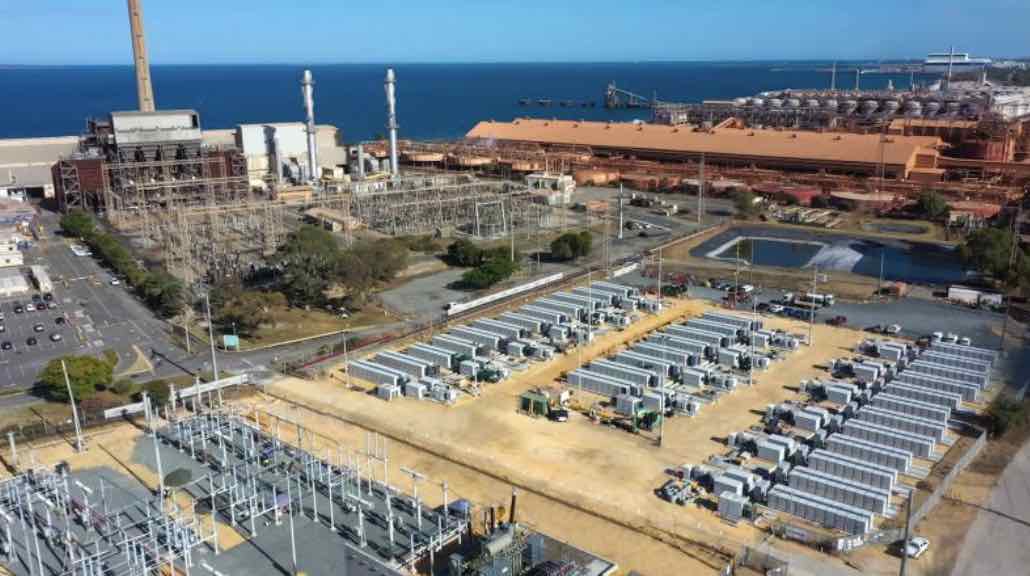
“Batteries are a good replacement for coal:” Utility unveils another 2,000MWh big battery
ShareTweetThe head of the dominant energy utility in Western Australia says that battery storage will be a good replacement for the state’s coal fired generators, which are due to close by the end of the decade.
The comments were made by David Fyfe, the CEO of the state-owned Synergy, as he unveiled yet another 2,000MWh battery project for the state, adding to the huge investments in battery storage unveiled over the last few months.
The 500MW, four hour South-West big battery will be built by 2029, joining the similar sized 2,000MWh battery at Collie planned by 2025, and two batteries at Kwinana – the 100MW/200MWh first stage that is already operating and a 200MW/800MWh second stage that will be complete by late next year.
Added to this is a 219MW four hour battery being built by Neoen in Collie, which could grow to a size of 1,000MW and 4,000MWh – potentially giving the state nearly 10,000GWh of large scale battery storage by the end of the decade, plus a growing number of household and virtual power plant batteries.
Fyfe says batteries will play a key role in the rapid transformation of the grid in the state – which he noted was the most isolated in the world and where the model around baseload coal no longer makes much sense.
“Coal is being displaced on a daily basis by rooftop solar,” Fyfe said on Wednesday at the Australian Energy Week conference in Melbourne. “That’s the equivalent of a fairly decent sized power station.”
The impact of this rooftop solar was low demand in the middle of the day, and often negative prices – and surging demand in the evening, along with high prices when Synergy is forced to buy from the market to ensure it has enough capacity to satisfy its customers.
“When I have to run coal fired power stations, which don’t like being turned on and off, I’m finding ourselves getting negative trading prices,” Fyfe said.
“So I have the cost of running the power stations and I’m also paying people .. to take our electricity. It’s a really poor business model.”
That’s why batteries are being brought in to help shift the output of the state’s rooftop systems en masse from the middle of the day to the evening.
It’s not just about prices: the market operator also wants what it calls “operating” demand to remain above 600MW to make it easier to manage the grid, which is why it has signed a lucrative contract with Neoen to mop up the largely “invisible” rooftop solar and shift it into the evening peaks.
It means that W.A. will have more four hour batteries – at Kwinana, Neoen’s Collie system and the two 500MW Synergy installations – than any other part of the country.
“We are very confident that battery storage will be a good replacement for our coal assets moving to 2030,” Fyfe says. (The last of the state run coal fired power stations at Collie are due to close in late 2029).
“Battery storage itself is continuing to advance, synthetic inertia, is now proven to be to be workable. The battery storage at Kwinana stage One was a two hour battery, all the rest of them are now going to be four hours as well,” Fyfe said.
“So when called upon six o’clock all the way through to 10 o’clock at night these batteries will be ready. It is a really important part of the energy infrastructure in Western Australia, and a really good way of decarbonising the system as well.”
That message is an important one for conservatives and renewable naysers to hear. Until now they have derided batteries as essentially useless, largely because they featured very short storage durations because of the initial focus on grid services.
Now that big batteries are moving into longer duration storage and time shifting renewables (one big battery in NSW will feature eight hours storage), that could help shift the debate – although one suspects that many critics simply don’t want to know.
Fyfe also talked of the learning process withiin the industry itself, as it learned to deal with new technologies such as air conditioning, rooftop solar, battery storage, and changing demand patters. He note the time when minimum demand levels first fell below 1,000MW in the state.
“We thought the world was going to cave in,” he said. Now minimum demand has already fallen below 600MW.
The same response came with the arrival of air-con is mass quantities across the country and then the first wave of rooftop solar.
“Remember when the air conditioners came onto the system and the network service providers at the time thought that was going to bring the network down. And it didn’t,” Fyfe said.
“And then (they thought) 250MW of rooftop solar coming onto the system was going to cause frequency issues, and we were going to get blackouts. And it hasn’t.”
Fyfe says Synergy now has a $3 billion investment plan for the big batteries and additional wind investments – at King Rocks and an expansion at Warradarge – as it prepares for the transition from coal to renewables, and then the growth of EVs and increased electricity demand from green industries and green hydrogen.
He noted that Synergy was currently looking at pumped hydro for longer duration storage, but such projects were difficult and also presented environmental challenges.
Interestingly, Fyfe also noted that WA’s status as an isolated grid – the biggest isolated grid in the world – was once considered an Achilles Heal, but was now regarded as a benefit.
“We have to be brave, and we have to be resilient,” Fyfe said.
“It isn’t easy. But it can be done, and it should be done.”